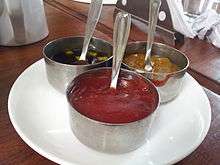Hot sauce
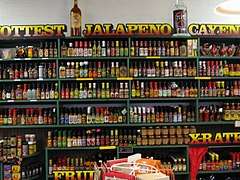
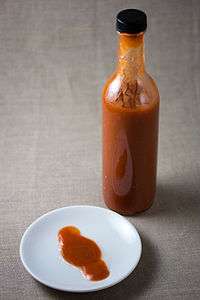
Hot sauce, also known as chili sauce or pepper sauce, is any condiment, seasoning, or salsa made from chili peppers and other ingredients. A very popular addition to different types of food, hot sauce allows individuals to enhance the flavor of their meals.
History
Humans have used chili peppers and other hot spices for thousands of years. Inhabitants of Mexico, Central America and South America had chili peppers more than 6,000 years ago. Within decades of contact with Spain and Portugal in the 16th century, the American plant was carried across Europe and into Africa and Asia, and altered through selective breeding.[1] One of the first commercially available bottled hot sauces in America appeared in 1807 in Massachusetts.[2] Few of the early brands from the 1800s survive to this day, however. Tabasco sauce is the earliest recognizable brand in the United States hot sauce industry, appearing in 1868. As of 2010, it was the number 13 best-selling seasoning in the United States[3] preceded by Frank's RedHot Sauce in 12th place, which was the sauce first used to create buffalo wings.[4]
Ingredients
Many recipes for hot sauces exist, but the only common ingredient is some variety of chili pepper. Many hot sauces are made by using chili peppers as the base and can be as simple as adding salt and vinegar. Other sauces use some type of fruits or vegetables as the base and add the chili peppers to make them hot.[5] Manufacturers use many different processes from aging in containers to pureeing and cooking the ingredients to achieve a desired flavor. Because of their ratings on the Scoville scale, Ghost pepper and Habanero peppers are used to make the hotter sauces but additional ingredients are used to add extra heat, such as pure capsaicin extract and mustard oil. Other common ingredients include vinegar and spices. Vinegar is used primarily as a natural preservative, but flavored vinegars can be used to alter the flavour.[6]
Styles
South and Central America
Belize
Belizean hot sauces are usually extremely hot and use habaneros, carrots, and onions as primary ingredients. Marie Sharp's is a popular brand of hot sauce produced in Dangriga.
Panama
In Panama Howler Monkey Sauce makes a traditional Panamanian hot sauce recipe, "Aji Chombo", made with Scotch Bonnet peppers. Picante Chombo D'Elidas is a popular brand in Panama, with three major sauces. The yellow sauce, made with habanero and mustard, is the most distinctive. They also produce red and green varieties which are heavier on vinegar content and without mustard.
Peru and Bolivian medium hot, frutal locoto sauces are popular.
Chile
The most popular sauce is the Diaguitas brand, made of pure red (very hot) or yellow (hot) Chilean peppers mixed only with water and salt. Other hot sauces are made from puta madre, cacho de cabra, rocoto, oro and cristal peppers, mixed with various ingredients. Mild hot sauces include some "creamy style" (like ají crema), or a pebre-style sauce, from many local producers, varying in hotness and quality.
North America

Mexico
Mexicans prefer to eat chili peppers chopped, but when making hot sauces they are typically focused more on flavor than on intense heat. Chipotles are a very popular ingredient of Mexican hot sauce and although the sauces are hot, the individual flavors of the peppers are more pronounced. Vinegar is used sparingly or not at all in Mexican sauces, but some particular styles are high in vinegar content similar to the American Louisiana-style sauces. Some hot sauces may include using the seeds from the popular achiote plant for coloring or a slight flavor additive. The process of adobos (marinade) has been used in the past as a preservative but now it is mainly used to enhance the flavor of the peppers and they rely more on the use of vinegar. Mexican-style sauces are primarily produced in Mexico but they are also produced internationally. The Spanish term for sauce is salsa, and in English-speaking countries usually refers to the often tomato-based, hot sauces typical of Mexican cuisine, particularly those used as dips. There are many types of salsa which usually vary throughout Latin America.
These are some of the notable companies producing Mexican style hot sauce.
- Búfalo A popular Mexican sauce
- Cholula Hot Sauce Known for its iconic round wooden cap
- Valentina A traditional Mexican sauce
United States
The varieties of peppers that are used often are cayenne, chipotle, habanero and jalapeño. Some hot sauces, notably Tabasco sauce, are aged in wooden casks similar to the preparation of wine and fermented vinegar. Other ingredients, including fruits and vegetables such as raspberries, mangoes, carrots, and chayote squash are sometimes used to add flavor, mellow the heat of the chilis, and thicken the sauce's consistency. Artisan hot sauces are manufactured by smaller producers and private labels in the United States. Their products are produced in smaller quantities in a variety of flavors. Many sauces have a theme to catch consumers attention. A very mild chili sauce is produced by Heinz and other manufacturers, and is frequently found in cookbooks in the U.S. This style chili sauce is based on tomatoes, green and/or red bell peppers, and spices; and contains little chili pepper. This sauce is more akin to tomato ketchup and cocktail sauce than predominantly chili pepper-based sauces.[7]
Louisiana-style
- Louisiana-style hot sauce contains red chili peppers (tabasco and/or cayenne are the most popular), vinegar and salt. Occasionally xanthan gum or other thickeners are used.
- Frank's Red Hot Which claims to be the primary ingredient in the first buffalo wing sauce
- Louisiana Hot Sauce Introduced in 1928, A cayenne pepper based hot sauce produced by Southeastern Mills, Inc., in New Iberia, Louisiana
- Mad dog 357 Introduced in 1991 by Ashley Food Company deemed one of the hottest hot sauces produced in the United States.[8]
- Tabasco sauce Earliest recognizable brand in the hot sauce industry, appearing in 1868.
- Texas Pete Introduced in 1929, developed and manufactured by the TW Garner Food Company in Winston-Salem, North Carolina
- Trappey's Hot Sauce Company was founded in 1898 Chili pepper water, used primarily in Hawaii, is ideal for cooking. It is made from whole chilies, garlic, salt, and water. Often homemade, the pungent end product must be sealed carefully to prevent leakage.[9] Sriracha sauce, a traditional Thai hot sauce, made primarily of ground chilies, garlic, vinegar, sugar, and salt. Often called "rooster sauce" after the most widely sold U.S. brand, Huy Fong Foods.
New Mexico
- New Mexican style chile sauces differ from others in that they contain no vinegar. Almost every traditional New Mexican dish is served with red or green chile sauce. The sauce is often added to meats, eggs, vegetables, breads, and some dishes are, in fact, mostly chile sauce with a modest addition of pork, beef, or beans.
- Green chile: This sauce is prepared from any fire roasted native green chile peppers, Hatch, Santa Fe, Albuquerque Tortilla Company, Bueno and Big Jim are common varieties. The skins are removed and peppers diced. Onions are fried in lard and a roux is prepared. Broth and chile peppers are added to the roux and thickened. Its consistency is similar to gravy, and it is used as such. It also is used as a salsa.
- Red chile: A roux is made from lard and flour. The dried ground pods of native red chiles are added. Water is added and the sauce is thickened.

West Indies
Hot pepper sauces, as they are most commonly known there, feature heavily in Caribbean cuisine like Caribbean style Bacchanal Pepper Sauce. They are prepared from chilli peppers and vinegar, with fruits and vegetables added for extra flavor. The most common peppers used are habanero and Scotch bonnet, the latter being the most common in Jamaica. Both are very hot peppers, making for strong sauces. Over the years, each island developed its own distinctive recipes, and home-made sauces are still common.[10]
Trinidad
Trinidad Scorpion is considered one of the hottest and most frutal families of strains, and is cultivated and hybridized in the United States, United Kingdom, Australia and elsewhere.
Barbados
- Bajan pepper sauce, a mustard and Scotch bonnet pepper based hot sauce.
Haiti
- Sauce Ti-malice, typically made with habanero, shallots, lime juice, garlic and sometimes tomatoes [11]
Puerto Rico
- Sofrito - small piquins ("bird peppers") with annatto seeds, coriander leaves, onions, garlic, and tomatoes Pique sauce is a Puerto Rican hot sauce made by steeping hot peppers in vinegar. Don Ricardo Original Pique Sauce, which is made with pineapple, is a Puerto Rican staple. Don Ricardo originated in Utuado (Spanish pronunciation: [uˈtwaðo]) a municipality of Puerto Rico located in the central mountainous region of the island known as La Cordillera Central.
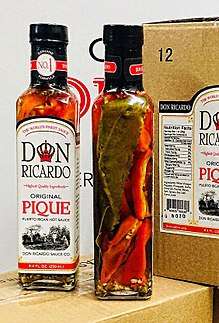
Jamaica
- Scotch bonnets are the most popular peppers used on Jamaica. They are often pounded with fruits such as mango, papaya and tamarind. Pickapeppa sauce is a Jamaican sauce.
Asia
East Asia
China
Chinese chili sauces usually come as a thick paste, and are used either as a dipping sauce or in stir frying.
- Dou ban sauce (là dòubànjiàng 辣豆瓣醬, là dòu jiàng là dòujiàng, dòubànjiàng 豆瓣醬), ("là" is "spice", "dou" is "bean", "bàn" is "piece", and "jiàng" is "sauce") originates from Szechuan cuisine in which chilis are used liberally. It is made from broad bean or soybean paste, and usually contain a fair amount of chili. Often referred to in English as chili bean sauce. Pao la jiao or yu la jiao (泡辣, 魚辣椒), dipped chili or fish chili, is made by pickling whole, fresh red chilis in a brine solution; this sauce is the key ingredient in the famous Sichuan dish Yúxiāng ròusī (魚香肉絲), julienned pork in fish fragrance sauce. The key to this pickle is to add a live crucian carp to the pickling pot along with the chilis, hence the name fish chili. The carp is supposed to lend its fragrance and umami to the pickle.
- Chili oil, Làjiāoyóu or hóngyóu (辣椒油, 紅油), is another distinctive Sichuan flavoring found mainly in cold dishes, as well as a few hot dishes. Chili oil or Lahtt Sauce is made by pouring hot oil onto a bowl of dried chilies, to which some Sichuan pepper is usually added. After steeping in hot oil for at least a few hours, the oil takes on the taste and fragrance of chili. The finer the chili is ground, the stronger the flavor (regional preferences vary - ground chili is usually used in western China, while whole dried chili is more common in northern China.)
- Guilin (Kweilin) chili sauce (Guìlín làjiāojiàng 桂林辣椒醬) is made of fresh chili, garlic and fermented soybeans; it also is marketed as soy chili sauce (la jiao jiang and la dou ban jiang are not the same thing, though they look vaguely similar in the jar). Duò jiāo sauce (duò jiāo 剁椒) originates from Hunan cuisine, which is reputed to be even spicier than Sichuan cuisine. Duo means chopped, and jiao means chili. Duo jiao is made of chopped red chilis pickled in a brine solution, and has a salty and sour pickled taste; it is the key flavoring in the signature Hunan dish duòjiāo yútóu (剁椒魚頭), fish head steamed with chopped chili.
- XO sauce (XO醬)
Japan
- Rāyu or La Yu chili oil (辣油, Chinese 辣椒油), is the same as la jiao you, and is often used for dishes such as gyoza. Shichimi tōgarashi (七味唐辛子) is a seven in one ingredient spicy seasoning mixes, with chili, used for many soups and foods, such as udon. Ichimi tōgarashi (一味唐辛子) is cayenne pepper powder. Okinawa - Kōrēgūsu (コーレーグース, 高麗胡椒), made of chilis infused in awamori rice spirit, is a popular condiment to Okinawan dishes such as Okinawa soba. It refers to Goguryeo.
Korea
- Gochujang (고추장)
South and Southeast Asia
Chili (Hindi: mirch), fresh, semi-dried or dried, is a crucial ingredient throughout South Asia, with multiple strains having arrived through Portuguese trade from the sixteenth century. Many varieties are now popular in different parts of the sub-continent such as Naga Chilli from Nagaland, Chamba Chukh from Himachal Pradesh, Guntur Chilli from Andhra Pradesh, Jwala Chilli from Gujarat among others. Hot sauces proper, however, were not common until recent decades, as varieties such as bhut jolokia and naga morich attained global fame.
Indonesia, Malaysia, Singapore, Brunei, Sri Lanka
- Sambal is a generic term for many varieties of chili-based sauces popular in Indonesia, Malaysia and Sri Lanka. Most of sambals are traditionally made using stone pestle and mortar, according to each recipe. Nevertheless, there are some bottled mass-produced sambal brands today. Saus Cabai (Indonesia) or Sos Cili (Malaysia), a category of its own, uses tomato puree, chili juice, sugar, salt and some other spices or seasonings to give the spicy, but not too hot, taste. Some countryside commercial varieties use bird's eye chili (cili padi, cabai rawit or burung) together with its seeds to raise the level of heat (piquancy) of the sauce. Variants include the typical concoctions with ginger and garlic (for chicken rice) and variants that are made into gummy consistency as with ketchup/tomato sauce.
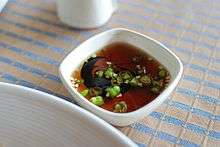
Thailand
Thais put raw chilies on a very wide variety of food, in lieu of chili sauces. Chili sauces are eaten as condiments but they can also be used as an ingredient.
- Nam phrik is the generic name for a Thai chili dip or paste. A Thai cookbook from 1974 lists over 100 different recipes.[12] Nam phrik phao (roasted chili paste), nam phrik num (pounded grilled green chili paste) and nam phrik kapi (chili paste made with fermented shrimp paste) are some of the more well-known varieties. Many Thai dipping sauces (nam chim) contain chili peppers. Nam chim chaeo uses ground dried chili peppers to achieve its spiciness. Available worldwide is nam chim kai, also known as "chili sauce for chicken" or "Thai sweet chili sauce". Phrik nam pla is fish sauce (nam pla) with chopped raw chilies, lime juice and sometimes garlic. Sriracha sauce is a Thai chili sauce, originally from the town of Si Racha, Thailand.
Vietnam
- Vietnamese hot sauce is made from sun-ripened chili peppers, vinegar, garlic, sugar and salt. It is very popular in Vietnamese cuisine, often used in a wide variety of foods.
Middle East and North Africa
Levant
- Shatta (Arabic: شطة shaṭṭah) is a popular hot sauce made from wholly grounded fresh chili peppers by mixing them with oil (usually olive). Vinegar, garlic, or other spices are commonly added. There are two varieties of Shatta: green and red. The red variety is made with tomatoes. It is made from piri piri, or similarly hot peppers. The degree of hotness varies according to the type of chili used and preference of the maker (homemade Shatta is usually hotter than commercial brands). Commonly used in falafel sandwiches, hummus dishes, or as a condiment. Muhammara (Arabic: محمرة muḥammarah) is a hot pepper dip made from Aleppo pepper, ground walnuts, dried bread, and olive oil. Other spices and flavorings may be added. It is served as a dip or spread for bread or as a sauce for fish and meat. The dish is also known in Turkey, where it may be called acuka.
Maghreb
- Harissa (Arabic: هريسة harīsah) is a popular hot sauce used in Tunisia and elsewhere in the Maghreb (especially Algeria and Libya). It is usually made from ground red birdseye chili peppers with olive oil, garlic, cumin and coriander although caraway is sometimes used instead of cumin and recipes vary. The sauce is of a dark red grainy texture. It is sometimes spread on bread rolls but also used as a condiment with a variety of meals. Tunisian Harissa is much hotter than that found in neighboring countries. Cap Bon is a popular brand of Harissa. Harissa is often sold in tin cans. Harissa is also popular in Israel, on account of immigration of Maghrebi Jews.
Yemen
- Sahawiq (Arabic: سحوق saḥawaq) is produced by grinding fresh peppers with garlic, coriander, and sometimes other ingredients. It is popular both in Yemen and in Israel, where it was brought by Yemenite Jews, and where it is called סחוג s'khug.
Sub-Saharan Africa
South Africa
Malawi
- Nali Sauce is a style of piri piri chili sauce.
Europe
United Kingdom
Two of the hottest chilies in the world, the Naga Viper[13] and Infinity chili were developed in the United Kingdom and are available as sauces which have been claimed to be the hottest natural chili sauces (without added pepper extract) available in the world[14] (The Naga Viper and Infinity were considered the hottest two chili peppers in the world until the Naga Viper was unseated by the Trinidad Moruga Scorpion in late 2011.)
Hungary
Erős Pista (lit. "Strong Steve") and Piros Arany (lit. "Red Gold") hot pepper paste, both made from minced hot paprika (Capsicum annuum L.); paprika is commonly grown in Hungary and both hot and mild paprika are in common usage there.
Portugal
Piri piri is the popular chili sauce; the term "piri piri" came to English through the Portuguese language through contact with Portuguese Mozambique.[15]
Oceania
Pacific Islands
The Pacific Islands are influenced by Asian and European cuisines. Hot chili sauce is a thick Chinese style sauce. Sweet chili sauce is a Thai style sweet dipping sauce. Peri Peri sauce is a Portuguese style piri piri sauce.
Australia
The availability of a wide variety of hot sauces is a relatively recent event in Australia (with little more than the flagship Tabasco cayenne variety and thick, medium hot Indochinese sauces widely available last century), although very faithful locally produced versions of habanero and Trinidad Scorpion sauces are now available.
New Zealand
Many influences reflecting the increasingly diverse ethnicity of its population. Common styles available in supermarkets are:
- Sweet chili sauce - a Thai style sweet dipping sauce (debatable as to whether this can be called a hot sauce).
- Hot sauces based on North and Latin American types (Tabasco, Huffman, Kaitaia Fire are most commonly available but Mexican and Peruvian branded sauces may also be found)
- Malaysian chili sauces with Indian influence
- Peri Peri sauce is a Portuguese style piri piri sauce that is also common in South Africa.
- Chinese style sauces such as black bean and chili.
Heat

The heat, or burning sensation, experienced when consuming hot sauce is caused by capsaicin and related capsaicinoids. The burning sensation is not "real" in the sense of damage being wrought on tissues. The mechanism of action is instead a chemical interaction with the neurological system.
The seemingly subjective perceived heat of hot sauces can be measured by the Scoville scale. The Scoville scale number indicates how many times something must be diluted with an equal volume of water until people can no longer feel any sensation from the capsaicin. The hottest hot sauce scientifically possible is one rated at 16,000,000 Scoville units, which is pure capsaicin. An example of a hot sauce marketed as achieving this level of heat is Blair's 16 Million Reserve (due to production variances, it is up to 16 million Scoville units), marketed by Blair's Sauces and Snacks. By comparison, Tabasco sauce is rated between 2,500 and 5,000 Scoville units (batches vary) - with one of the mildest commercially available condiments, Cackalacky Classic Condiment Company's Spice Sauce, weighing in at less than 1000 Scoville units on the standard heat scale.
A general way to estimate the heat of a sauce is to look at the ingredients list. Sauces tend to vary in heat based on the kind of peppers used, and the further down the list, the less the amount of pepper.
- Cayenne - Sauces made with cayenne, including most of the Louisiana-style sauces, are usually hotter than jalapeño, but milder than other sauces.
- Chile de árbol - A thin and potent Mexican chili pepper also known as bird's beak chile and rat's tail chile. Their heat index uses to be between 15,000 and 30,000 Scoville units, but it can reach over 100,000 units. In cooking substitutions, the Chile de árbol pepper can be traded with Cayenne pepper.
- Habanero - Habanero pepper sauces were known as the hottest natural pepper sauces, but nowadays species like Bhut jolokia, Naga jolokia or Trinidad Scorpion Moruga are even five or ten-fold hotter.
- Jalapeño - These sauces include green and red jalapeño chilis, and chipotle (ripened and smoked). Green jalapeño and chipotle are usually the mildest sauces available. Red jalapeño sauce is generally hotter.
- Naga Bhut Jolokia - The pepper is also known as Bhut Jolokia, ghost pepper, ghost chili pepper, red naga chilli, and ghost chilli.[16] In 2007, Guinness World Records certified that the Ghost Pepper (Bhut Jolokia) was the world's hottest chili pepper, 400 times hotter than Tabasco sauce; however, in 2011 it has since been superseded by the Trinidad Moruga Scorpion.
- Piri piri - The Peri Peri pepper has been naturalized into South Africa and is also known as the African Bird's Eye pepper, Piri-Piri pepper or Pili-Pili pepper, depending on what area of the country you’re in. The pepper ranges from one half to one inch in length and tapers at a blunt point. The small package packs a mighty punch with a 175,000 rating on the Scoville scale, near the Habanero, but the Peri Peri is smaller and has a much different flavor. It is most commonly used in a hot sauce, combined with other spices and seasonings because it has a very light, fresh citrus-herbal flavor that blends well with the flavors of most other ingredients.[17]
- Scotch Bonnet - Similar in heat to the Habanero are these peppers popular in the Caribbean. Often found in Jamaican hot sauces.
- Tabasco peppers - Sauces made with tabasco peppers are generally hotter than cayenne pepper sauces. Along with Tabasco, a number of sauces are made using tabasco peppers.
- Trinidad Moruga Scorpion The golf ball-sized chili pepper has a tender fruit-like flavor. According to the New Mexico State University Chile Institute, the Trinidad Scorpion Moruga Blend ranks as high as 2,009,231 SHU on the Scoville scale.
- Carolina Reaper - The Carolina Reaper® is a super hot pepper which has been described as a roasted sweetness delivering an instant level of heat. Developed by Puckerbutt Founder Ed Currie in Rock Hill, South Carolina, the Carolina Reaper averages over 1.5 million SHU and was awarded the Guinness World Record in November of 2013.
- Capsaicin extract - The hottest sauces are made from capsaicin extract. These range from extremely hot pepper sauce blends to pure capsaicin extracts. These sauces are extremely hot and should be considered with caution by those not used to fiery foods. Many are too hot to consume more than a drop or two in a pot of food. These novelty sauces are typically only sold by specialty retailers and are usually more expensive.
- Other ingredients - heat is also affected by other ingredients. Mustard oil and wasabi can be added to increase the sensation of heat but generally, more ingredients in a sauce dilute the effect of the chilis, resulting in a milder flavor. Many sauces contain tomatoes, carrots, onions, garlic or other vegetables and seasonings. Vinegar or lemon juice[18] are also common ingredients in many hot sauces because their acidity will help keep the sauce from oxidizing, thus acting as a preservative.
Remedies
Capsaicinoids are the chemicals responsible for the "hot" taste of chili peppers. They are fat soluble and therefore water will be of no assistance when countering the burn. The most effective way to relieve the burning sensation is with dairy products, such as milk and yogurt. A protein called casein occurs in dairy products which binds to the capsaicin, effectively making it less available to "burn" the mouth, and the milk fat helps keep it in suspension. Rice is also useful for ameliorating the impact, especially when it is included with a mouthful of the hot food. These foods are typically included in the cuisine of cultures that specialise in the use of chilis. Mechanical stimulation of the mouth by chewing food will also partially mask the pain sensation.[19]
See also
- Chili pepper water
- List of condiments
- List of hot sauces
- Sambal, sauce typically made from a variety of chili peppers.
- Jerk spice, a marinade of spices and hot peppers commonly used in Jamaican cuisine.
- Pepper jelly
- Scoville scale
References
- ↑ Brown, David (February 16, 2007). "One Hot Archaeological Find". The Washington Post. Archived from the original on October 16, 2017.
- ↑ Thompson, Jennifer Trainer (2012-04-24). Hot Sauce!. North Adams, MA: Storey Pub. p. 15. ISBN 978-1-60342-813-2.
- ↑ "The Best-Selling Condiments in the U.S.: No. 13 Best-Selling Condiment: McIllhenny Tabasco Sauce". BusinessWeek. Archived from the original on 2013-04-28. Retrieved 2013-04-14.
- ↑ "The Best-Selling Condiments in the U.S.: No. 12 Best-Selling Condiment: Frank's RedHot Sauce". BusinessWeek. Archived from the original on 2013-04-07. Retrieved 2013-04-14.
- ↑ Chili History and Hot Sauce. Archived from the original on 2016-10-12.
- ↑ Tate, Nate; Tate, Mary Kate (2011-09-20). Feeding the Dragon: A Culinary Travelogue Through China with Recipes. ISBN 9781449408480.
- ↑ Rombauer, I: Joy of Cooking, p. 847. Bobbs-Merrill, 1975.
- ↑ "Sudbury Firm Gets Fired Up About Its Sauces". February 2010. Archived from the original on 2015-07-23.
- ↑ "Slash Food Article on Chili Pepper Water". Archived from the original on March 4, 2013.
- ↑ "Reggae Reggae lies! Sauce millionaire Levi Roots admits 'I lied on Dragons' Den - it wasn't my grandmother's recipe'". dailymail.co.uk. Archived from the original on 2012-08-01.
- ↑ "Whats 4 Eats recipe for Sos Ti-Malice". Archived from the original on 2012-12-01.
- ↑
- ↑ "Hottest chili". Guinnessworldrecords.com. 2011-03-01. Archived from the original on 2011-09-03. Retrieved 2013-03-02.
- ↑ Fire Foods. "Hot Chilli Sauce Online | Hot Chili Sauce UK | Hottest Chilli Products". Firefoods.co.uk. Archived from the original on 2013-01-29. Retrieved 2013-03-02.
- ↑ "Archived copy". Archived from the original on 2012-12-18. Retrieved 2012-12-20.
- ↑ "''Ghost Chili'' Scares Off Elephants". News.nationalgeographic.com. Archived from the original on 2010-03-29. Retrieved 2010-04-11.
- ↑ "Peri-Peri Peppers". Archived from the original on 2014-02-03.
- ↑ "Does Hot Sauce Go Bad?". Archived from the original on 2015-04-02. Retrieved 2015-03-10.
- ↑ Nasrawi, Christina Wu; Pangborn, Rose Marie (April 1990). "Temporal effectiveness of mouth-rinsing on capsaicin mouth-burn". Physiology & Behavior. 47 (4): 617–623. doi:10.1016/0031-9384(90)90067-E. PMID 2385629.
External links


